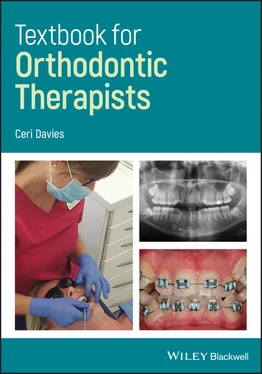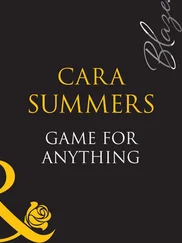The brackets came in two different sizes:Width usually 0.018 or 0.022 in.Depth usually 0.025 or 0.028 in.
The appliance had three‐dimensional control of the teeth.
To aid tooth movement all archwires were dependent on bends being added. However, this was time consuming and difficult for the orthodontist, as it was required at every visit.
The bends created were to achieve the following ( Figure 1.2):First‐order bend – in and out:To compensate for the different tooth widths, bends are placed in the horizontal plane of the archwire.The bends correct the tooth widths in the bucco‐lingual and labial‐palatal direction (anterio‐posterior [AP] plane – anterior/posterior movement, front to back).For example: in modern‐day orthodontics, central incisors are always slightly in front of the lateral incisors, which sit slightly back. Canines sit in the same anterio‐posterior position as the central incisors, which helps to create the canine eminence (corner of the mouth).Second‐order bend – tip:To compensate and correct the angulation of the teeth, bends are placed in the vertical plane to achieve the correct mesiodistal angulation of the teeth.For example: distally angulated laterals would need bends to help upright the laterals mesially, which ensures that teeth gain the desired angulation.Third‐order bend – torque (rectangular wire only):This is achieved with rectangular archwires only.Orthodontists would place a bend in the archwire to help correct the torque of the roots.For example: buccal root torque is achieved by the archwire being twisted forwards; palatal root torque is achieved by the archwire being twisted backwards.
Closing loops were placed within the archwire and used as a method of space closure.
This system placed a high demand on anchorage.
Tooth movement can be effected due to the inter‐bracket span, the distance between the brackets:Narrow brackets (more span): a greater span of the archwire between the brackets has the ability to make the archwire more flexible, which can achieve faster alignment.Wider brackets (less span): a reduced span of the archwire between the brackets is more efficient for de‐rotation and mesiodistal control of teeth.
P. Raymond Begg (1898–1983):
Developed the Begg appliance in the 1950s.
An Australian dentist.
Attended the Angle School of Orthodontia in Pasadena, California in 1924 and was one of the first at the school to treat patients with the standard edgewise appliance.
In 1925 he travelled back to Adelaide, South Australia to treat his own patients in orthodontics.
Became a professor at the University of Adelaide.
Was also known to develop the Australian orthodontic wires.
In 1980 he retired and then died in 1983.
Begg appliance ( Figure 1.3):
This appliance was designed to overcome the high anchorage demand of the standard edgewise appliance and is a light anchorage appliance.
Another name for the Begg appliance is the lightwire appliance.
The components of the appliance are the bracket, pin, and archwire. Figure 1.3 A Begg appliance. The components of the bracket are labelled. Figure 1.4 How the Begg appliance works. (a) The teeth are tipped into the desired position by the use of inter‐maxillary elastics. The lines on the photograph show the inclination of how the upper and lower teeth sit. (b) The roots of these teeth are uprighted by the use of auxiliary springs.
To ensure full engagement of the archwire, the pin is used to hold the archwire within the bracket slot.
The appliance is dependent on round archwires only, which fit loosely into the bracket slot at the top of the bracket – this allows a lot of slop (play) within the bracket.
Final detailing of teeth is difficult to achieve in this type of appliance.
The Begg appliance uses different methods to gain tooth movement ( Figure 1.4):
Round archwires and inter‐maxillary elastics tip the teeth into the desired position.
Auxiliary springs or loops are placed within the archwire to help upright the roots of the teeth and achieve rotational movement.
To provide intra‐oral anchorage, extractions can be considered, since intra‐oral elastic wear would use the posterior segment as an anchor unit to help retract the anterior segment.
Patient compliance is important throughout treatment with this appliance, as it is very dependent on intra‐oral elastics.
1.4 Preadjusted Edgewise Appliance
Lawrence Andrews:
Developed the preadjusted edgewise appliance in 1970.
Also developed Andrews’ six keys to occlusion.
Is an American orthodontist who has now retired from patient care, although he still takes part in research and education.
His son Will A. Andrews followed in his footsteps and joined the practice that Lawrence established in 1958 called Point Loma in San Diego, California.
Preadjusted edgewise appliance ( Figure 1.5):
Another name for this is the straight‐wire appliance.
It is used on patients for either their first stage of treatment or the second stage following removable or functional appliances.
These brackets are called ‘preadjusted’ edgewise brackets because they are thicker in the horizontal dimension, and are also different from one another due to the inbuilt prescriptions designed specifically for each individual tooth. Figure 1.5 Preadjusted edgewise brackets.
The inbuilt prescriptions within the brackets are:In and out: first‐order bendTip: second‐order bendTorque: third‐order bend.
Because of the inbuilt prescriptions within the brackets they became very popular, as it meant wire bending was minimised and in some cases not needed at all.
For the inbuilt prescriptions to be achieved on each tooth, the brackets are manufactured in a certain way:In and out (first‐order bend): to achieve this, the base of the bracket is manufactured differently. For example, lateral incisors sit slightly back from the central incisors, therefore the base of this bracket will be thicker than the brackets for the central incisors.Tip (second‐order bend): each bracket slot is cut at a certain angulation to help achieve the correct angulation for each individual tooth; this differs for each bracket.Torque (third‐order bend): each bracket has different torque percentages within the bracket slot. The thicker the wire, the more torque is created. If the desired torque is not achieved, bends within archwires can be placed to help with this type of movement.
Preformed archwires are used with this appliance, as this allows teeth to move gradually from their original position into their desired position.
Brackets come in different slot sizes:0.018 × 0.025 in., with the working wire being used = 16 × 22 ss (stainless steel)0.022 × 0.028 in., with the working wire being used = 19 × 25 ss (more commonly used).
Depending on the degree of crowding the patient presents with, the appliance can be used on non‐extraction or extraction cases.
Still in good use today, the preadjusted edgewise appliance has three common bracket prescriptions:AndrewsRothMBT = McLaughlin, Bennett, Trevisi.
Different orthodontists created these three common bracket prescriptions. It was known that each orthodontist had different views on how much torque should be built within the bracket slot. Therefore, each bracket prescription contains different values of torque, with MBT containing the highest value of torque out of the three.
Advantages of the edgewise appliance:
Reduced chair time.
Amount of wire bending is minimised.
Sliding mechanics for tooth movement.
Good finishing.
Disadvantages:
Larger inventory of brackets is required, as each individual tooth has different requirements of in and out, tip and torque.
Читать дальше












